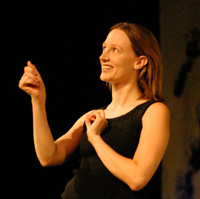By Katie Knutson
Many Storytellers, especially those who work with children, talk about doing residencies. Often we forget that newer tellers might not know what we are talking about. This is especially confusing when the term “Artist Residency” means two very different things.

A School or Arts Learning Residency
In my experience, when most storytellers talk about residencies they are referring to extended, arts-learning experiences, often offered in schools. These are classes, or sessions, delivered to students one classroom at a time, as opposed to assembly performances, where many classrooms come together to listen.
School residencies are often centered around a theme (e.g., bullying prevention, Italian folklore, life cycles of insects) and align with the school’s curriculum, goals, and/or state (or Common Core) educational standards. The length can vary from a single session to multiple sessions over many months. The goals of residencies vary greatly; sometimes teachers and administrators want a finished product, like a performance or piece of writing, and other times the goals are more skill or process-based, like critical thinking, observation, empathy, or teacher arts integration. There is usually at least one “core group” of students who participate in multiple sessions throughout the residency to work extensively on a particular skill, product, or goal.
A residency should allow students to learn through an art form, teaching fundamentals of both the art and the subject matter. For example, when doing an extended residency on the Civil War, in addition to telling stories about the war and its impact on a variety of people, you may cover research strategies, story arc, civil rights, vocal projection, characterization, and the Battle of Gettysburg, among other things. Before this kind of residency, the teaching artist, either singly or with the classroom teacher, creates lesson plans spelling out the goals and specific activities of each session. Additionally, all arts learning residencies should have built-in evaluations and embedded professional development for the teacher.
Alternately, this kind of residency can take place in Senior Centers, after-school programming sites, museums, daycare centers, adult day centers, libraries, and any other gathering places where people might want to learn in or through an art form.
The Artist Colony, Retreat, Studio Collective, Workspace, or Community
Most often called simply an Artist Residency, these programs open their doors to artists to give them focused time and space to practice their art and create new work. Approximately 500 programs exist in the U.S., with three times that number happening in at least 42 other countries, in both rural and urban settings. These residencies usually provide food and housing, almost unlimited studio time, and support for artists. Some charge a small fee, while others provide stipends. Either way, there is a selective application process.
Lasting from two weeks to a year, these programs usually involve some kind of community involvement, such as a concert, workshop, or artist meet-and-greet, but may also involve more extensive, hands-on, community-based work. Some of these programs host one artist at a time, while others invite up to 50 artists to live, explore, and create together.
For more information on these two types of residencies, see “Planning Your First Storytelling Residency,” earlier on the NSN blog (http://blog.storynet.org/planning-your-first-storytelling-residency), which includes a list of resources for school residencies, or check out the Alliance of Artists Communities (http://artistcommunities.org/), with loads of information about artist retreats.
Have you participated in or taught either kind of residency? Please share your most memorable moments below!
About Katie
Katie Knutson is a Storyteller and Teaching Artist based in Minneapolis. In addition to writing or curating this column (New Voices), she performs regularly, leads workshops for storytellers and teachers, and spends time with her kindergartner. She is the Storyteller-in-Residence/Arts Integration Specialist at Folwell K-8 School. More at www.ripplingstories.com.
